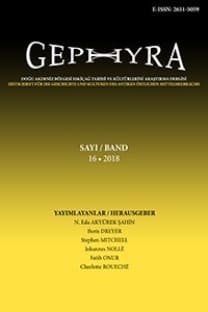Bozüyük'ten (Lamunia) Yeni Bir Epigram
: Bithynia, Bozüyük, Lamunia, stel, epigram
A New Epigram from Bozüyük (Lamunia)
___
- Phrygia; Archaeological Discussions: Asia Minor, Ancient Phrygian Civilisations, AJA 3, 1899, 601-602.
- P. Frei, Epigraphisch-topographische Forschungen im Raum von Eskişehir, Araştırma Sonuçları Toplantısı I, Ankara 1984, 53-62.
- P. Frei, Inschriften und Reliefs. Ein Beitrag zur lokalen Religionsgeschichte Anatoliens, in: S. Buzzi – D. Käch – E. Kistler – E. Mango – M. Palacyzk –
- O. Stefani [Hrgs.], Zona Archaeologica. Festschrift für Hans Peter Isler zum 60. Geburtstag, Bonn 2001, 135-158.
- A. Körte, Ein altphrygischer Tumulus bei Bos-öjük (Lamunia), Athen. Mitt. 24, 1899, 1-45.
- R. Merkelbach - J. Stauber, Die Steinepigramme aus dem griechischen Osten 2. Die Nordküste Kleinasiens (Marmarameer und Pontos), München – Leipzig 2001.
- R. Merkelbach - J. Stauber, Die Steinepigramme aus dem griechischen Osten 3. Der 'Ferne Osten' und das Landesinnere bis zum Tauros, München – Leipzig 2001.
- W. Ruge, RE XII,1, 1924, col. 594, s.v. Lamunia.
- W. Ruge, RE XX,1, 1941, col. 840, s.v. Phrygia (Topographie).
- S. Şahin, Katalog der antiken Inschriften des Museums von İznik [Nikaia], Bonn 1981 [IK 10, II 1].
- S. Şahin, Studien über die Probleme der historischen Geographie des nordwestlichen Kleinasiens I. Strabon XII 3,7 P. 543. Der Fluss Gallos, die Stadt Modr
e in Phrygia Epiktetos und die Schiffbarkeit des Sangarios, Epigr. Anat. 7, 1986, 125-152. - S. Şahin, ΟΥΔΕΙΣ ΑΘΑÎΑΤΟΣ in den Grabinschriften aus der Gegend von Germanikeia (Maraş) in Kommagene, in: H. Malay (Hrsg.), Erol Atalay Memorial, İzmir 1991, 183-190.
- P. Wittek, Von der byzantinischen zur türkischen Toponymie, Byzantion 10, 1935, 11-64.
- L. Zgusta, Kleinasiatische Ortsnamen, Heidelberg 1984.
- ISSN: 1309-3924
- Yayın Aralığı: Yılda 2 Sayı
- Başlangıç: 2004
- Yayıncı: Nalan Eda AKYÜREK ŞAHİN
Stadiasmus Patarensis için Parerga (2) Sidyma I. Yeni Yazıtlarla Birlikte Yerleşim Tarihçesi
Stadiasmus Patarensis için Parerga (3) Orta Lykia'da Köybaşı Yerleşimindeki Yazıt Hakkında
Bursa Müzesi'nden Yeni Mezar Yazıtları
Stadiasmus Patarensis için Parerga (4) Milyas'taki Mikron Oros Akarassos
Isparta Müzesi'nde Bulunan Bazı Yazıtlar
Güneydoğu Isauria Bölgesinde Bulunan Karakabaklı Tetrapylonları
13. ve 14. Yüzyıllarda Likya Limanı Patara ve Çevresi - Bir Yorum -
Bozüyük'ten (Lamunia) Yeni Bir Epigram
Bithynialı bir Hayvan Savaşçısının (archikynegos) Sosyal Yükselişi
Perge Ekklesiasterion ve Bouleuterion Yapı ve İthaf Yazıtları için Düzeltme
